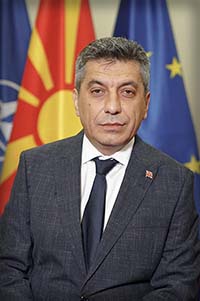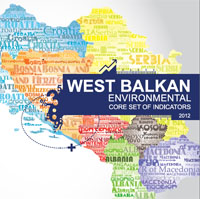| EMMISSION OF THE MAIN POLLUTING SUBSTANCES – EMISSION OF NITROGEN OXIDES EXPRESSED AS NITROGEN DIOXIDE (NOx) |
The indicator tracks the trends innitrogen oxides expressed as nitrogen dioxide.
kt (kilotons per year)
What progress has been made in overall reduction of emissions of nitrogen oxides expressed as nitrogen dioxide in the Republic of Macedonia?
In 1990, the overall national emissions of NOx amounted to 44 kt. Since then, emissions have been reduced so that in 2016 emissions are at around 21.6 kt, ie 51% of emissions in 1990. The reasons for the reduction are due to the significantly reduced emissions from the energy production industry (Public Energy and Power Plants) due to the reduced quantity of coal use in REK Bitola and the use of national emission factors, in order to comply with the inventory for greenhouse gases, which were used in 2016 and which are about 30% smaller compared to the emission factors that were used for emissions in 2015. For these reasons, a difference of 46% was observed in relation to NOx emissions in 2016 compared to 2015 with a declining trend. Also, in 2015 and 2016, REK Oslomej worked only one month in each year. An increase of emissions in 2006 and 2007 was caused by increased consumption of crude oil in the NFR category 1A1a, while sharp drop of emissions between 2011 and 2012 resulted from reduced consumption of coal in large thermal power plants. In the period 2012-2013, reduction in the emission was due to the reduced time of operation of the second in size power plant – REK Oslomej, from 12 to 5 months and reduced consumption of coal by as much as 60%. Lower emissions of NOx in 2013 compared to 2012 were also result of the boilers modernization in the biggest thermal power plant REK Bitola.
The Diagram below shows annual trend in the emissions of nitrogen oxides expressed as nitrogen dioxide for the period 1990 to 2016.
Diagram 1.Trend in emissions of nitrogen oxides expressed as nitrogen dioxide
Under the CARDS Programme, Inventory of air emissions of the main pollutants in the country was established in 2005 in accordance with the EMEP methodology by individual sectors, i.e. activities, and in 2014 Inventory including all pollutants was prepared.Starting from 2014, the Republic of Macedonia carries out calculations of national emissions for all pollutants.
The emission sources, within this national indicator, are made according to the following categorization:
| Sector |
| Energy Production and distribution |
| Commercial, instiucional and households |
| Industry (combustion) |
| Industry (production) |
| Fugitive emissions |
| Use of solvents and products |
| Road transport |
| Non-Road transport |
| Waste |
| Agriculture |
| Other |
The main source of emissions in 2016 is the sector Energy production and distribution with a share of 41,1%. The sector Road transport, contributes with a share of 28,7%, followed by the sectors Industry (Combustion) with a share of 12,2% and Non-Road transport with a share of 11,7%.
Diagram 2. Emissions ofNOxbysectors per year in 2016
Which different sectors and processes contribute to nitrogen oxides emissions?
NFR category 1A1a is the key sector in nitrogen oxide emissions. There is a decrease in emissions in 2014 compared to emissions in previous years, due to the reduction of emissions of nitrogen oxides from transport and combustion from production installations and construction. In 2015, the reduction of NOx emissions is insignificant compared to 2014 while a significant decrease is observed in 2016 due to the reduced amount of coal used in REK Bitola and the use of national emission factors, in order to comply with the GHG inventory, which were used in 2016 and which are about 30% smaller compared to the emission factors that were used till 2015. In 2013 and 2014, roughly equal emissions of nitrogen oxides are recorded, which, compared to 2011 and 2012, are lower due to the reduced capacity of REK Oslomej. The lower emissions of NOx from NFR category 1A1 in 2013 and 2014 compared to 2012, are also a result of the modernization of the boilers in the largest thermal power plant REK Bitola.
Diagram 3. Emissions of NOxby NFR sectors per year
 Data coverage: excel_1, excel_2
Data coverage: excel_1, excel_2
Sources of data: The data used refers to overall national emissions and emissions categorized by NFR delivered by EEA member and collaborating states to EEA and Secretariat of the United Nations. Data is accessible per country on the following web address:http://cdr.eionet.europa.eu/mk/un/clrtap/inventories/envwovm7g/.
- Methodology for indicator calculation
The methodology for this indicator calculation is based on calculated national emissions and emissions by NFR sectors of this pollutant as reported to EEA (European Environmental Agency) and UNECE/EMEP (United Nations Economic Commission for Europe/Cooperative programme for monitoring and evaluation for transboundary air pollution transfer under the Convention on Transboundary Air Pollution Transfer) in February 2016. Data used in this report is in accordance with the data submitted, the difference being that additional allocation of national emissions has been made apart from NFR (as sent to international organizations) also by sectors.
Calculations are in line with the Guidebook of EMEP/EEA on air emissions inventory taking published in 2009, 2013 and 2016. The Guidebook contains emission factors which have been used in the calculations, except for the energy sector where calculations were made by use of country specific factors or use of data from the measurements completed in the period 2008-2016, for this polluting substance for the NFR category 1A1a, concerning electricity and heat producing plants.
Methodology used for calculation and presentation of this indicator is given in EMEP/EEA Guidebook for inventory of air pollutant emissions of 2009, Guidebook of 2013 and Guidebook of 2016 which may be accessed at the following links (http://www.eea.europa.eu/publications/emep-eea-emission-inventory-guidebook-2009, http://www.eea.europa.eu/publications/emep-eea-emission-inventory-guidebook-2013 and http://www.eea.europa.eu/publications/emep-eea-guidebook-20136).
Action Plan for European Partnership, as well as National Plan for approximation of the national legislation with European regulations specifying bylaws that need to be prepared have been adopted.
The National Environmental Action Plan (NEAP II) was adopted. It contains the measures that need to be taken to improve the overall status of air quality, including the reduction of emissions of acidifying substances. The National Plan for Ambient Air Protection for the period 2012 to 2017 specifying the measures for air protection on national level and the National Programme for gradual air emissions reduction from 2012 to 2020 have been adopted in order to define and implement measures on national level concerning reduction of nitrogen oxides emissions and achievement of projected values for the total emission of this polluting substance on national level.At the same time, for the purpose of air quality improvement in certain local self-government units (LSGUs) with action plans, program was prepared for the City of Bitola. Air quality plans and short term action plans for city of Skopje and city of Tetovo were prepared in the Twining project “Further strengthening of the capacities for effective implementation of the acquis in the field of air quality”, which were adopted by the coouncils of the municipalities. A National plan for reduction pollution for sulphur dioxide (SO2), nitrogen oxides (NOx) and dust (TSP) for existing Large Combustion Plant (LCP) was prepared. The plan was approved by the Energy Community and the revised plan was adopted by the Government of the Republic of Macedonia in December 2017.
Does any of the national documents set target or target should be achieved in accordance with other international documents?
National strategic documents listed as references in the above text provide guidelines and specify actions that should be undertaken as a matter of priority. It is important to mention thatbylaws have been prepared in the area of air emissions transposing Directives 96/61/EC, 2000/81/EC, 2000/76/EC, 99/13/EC and 2001/81/EC, ranging between 90 and 100%.
In accordance with the requirements of the UNECE Convention on Long-Range Transboundary Air Pollution, inventory based on EMEP/EEA Guidebook for inventory of polluting substances into the air, setting the target of regular inventory of pollutants in tons per year following the n-2 principle, where n is the current year.
Also, in accordance with Directive 2001/81/ЕC, as well as Gothenburg Protocol, the ceilings of the amounts of emissions have been set at the level of the Republic of Macedonia for 2010 that shall not be exceeded at the annual level of 2010. The Executive Body of the Convention on Long-Range Transboundary Air Pollution, upon submission of the values of national ceilings in order to enrol the Republic of Macedonia in Annex II of the Gothenburg Protocolrequested correction of the values considering the reported data on air emissions of the pollutants sulfur dioxide and ammonia at national level. Changes in the values of these pollutants were incorporated in the Rulebook amending the Rulebook on upper limits – emission ceilings of pollutants for the purpose of setting projections for certain period concerning reduction of the quantities of pollutant emissions at annual level published in July 2014. This Rulebook also sets the national upper limit – ceiling for the emissions of nitrogen oxides expressed as nitrogen dioxide of 39 kilotons. The national upper limit-ceiling for NOx has not been exceeded for the last three years.
Diagram 4. Comparison of the emissions of NOxin the period 2014-2016 with the upper limit-ceiling for 2010
 According to the results presented in Diagram 4, it may be concluded that the Republic of Macedonia is in compliance with the Gothenburg Protocol for this polluting substance. For this polluting substances, targets are also set in the Protocol to 1979 Convention on Long-Range Transboundary Air Pollution concerning control of nitrogen oxides releases or their transboundary transfers, under which the emissions in n-2 year (where nis the current year) should not exceed the emissions in the baseline year (being 1987 for our country)and the country is compliant with this Protocol in relation to emissions calculated for 2016.
According to the results presented in Diagram 4, it may be concluded that the Republic of Macedonia is in compliance with the Gothenburg Protocol for this polluting substance. For this polluting substances, targets are also set in the Protocol to 1979 Convention on Long-Range Transboundary Air Pollution concerning control of nitrogen oxides releases or their transboundary transfers, under which the emissions in n-2 year (where nis the current year) should not exceed the emissions in the baseline year (being 1987 for our country)and the country is compliant with this Protocol in relation to emissions calculated for 2016.
With reference to the targets – projections for NOx for 2015 (33.7 kilotons) scenario with measures set in the Programme for gradual reduction of emissions of certain polluting substances at the level of the Republic of Macedonia with projections for the reductions in the period between 2012 and 2020, were achieved in 2014.
REK Bitola is already undertaking activities for finding finances for the start of the desulphurization process, which would result in reduction in the emissions of nitrogenoxides.
Legal basis
The Law on Ambient Air Quality adopted in August 2004 and amended several times afterwards (Official Gazette of RM no. 67/2004, 92/2007, 83/2009, 35/10, 47/11, 100/12, 163/2013,10/2015 и 146/2015) is framework law in the area of air. The goals of this Law include avoiding, prevention and reduction of harmful effects on human health and environment as a whole, prevention and abatement of pollutions leading to climate change, as well as provision of appropriate information on the quality of ambient air.
On the basis of the Law on Ambient Air Quality, 16 bylaws were prepared and adopted to introduce limit values for air quality and air emissions, methodology of air quality and air emissions monitoring, manner of preparation of planning documents for air protection against pollution, manner of informing the citizens and international organizations, etc.
In 2010, all 8 Protocols to the Convention on Long-Range Transboundary Air Pollution – CLRTAP were ratified. Owing to the requirement for amendment of the annexes with regard to emissions in the baseline year (1990) and national emission ceilings for 2010, the Gothenburg Protocol and 1995 Protocol on sulphur entered into force for the Republic of Macedonia in 2014 upon adoption of the values set in Annex II of these Protocols. In relation to the obligations for calculation of emissions of nitrogen oxides, the following protocols or international ratified agreements are of relevance:
- Protocol to 1979 Convention on Long-Range Transboundary Air Pollution concerning control of nitrogen oxides releases or their transboundary transfers. The Protocol was ratified by the Law on Ratification (Official Gazette of RM no. 24/2010);
- Protocol to 1979 Convention on Long-Range Transboundary Air Pollution concerning reduction of acidification, eutrophication and ground ozone (Gothenburg, 1999). The Protocol was ratified by the Law on Ratification (Official Gazette of RM no. 135/2010),while Republic of Macedonia became an equal member of the protocol in 2014.
- Reporting obligations towards international agreements – UNECE-CLRTAP and ЕЕА
- Annual Report of Processed Data on Air Emissions
| Code | Title of the indicator | Compliance with CSI ЕЕА or other indicators | Classification by DPSIR | Type | Linkage with area | Frequency of publication | |
| MK NI 050 | Emissions of the main polluting substances – nitrogen oxides (NOx) | EEA
UNECE |
CSI 040,
APE 010 A1/2 |
P | B |
|
annually |







































































